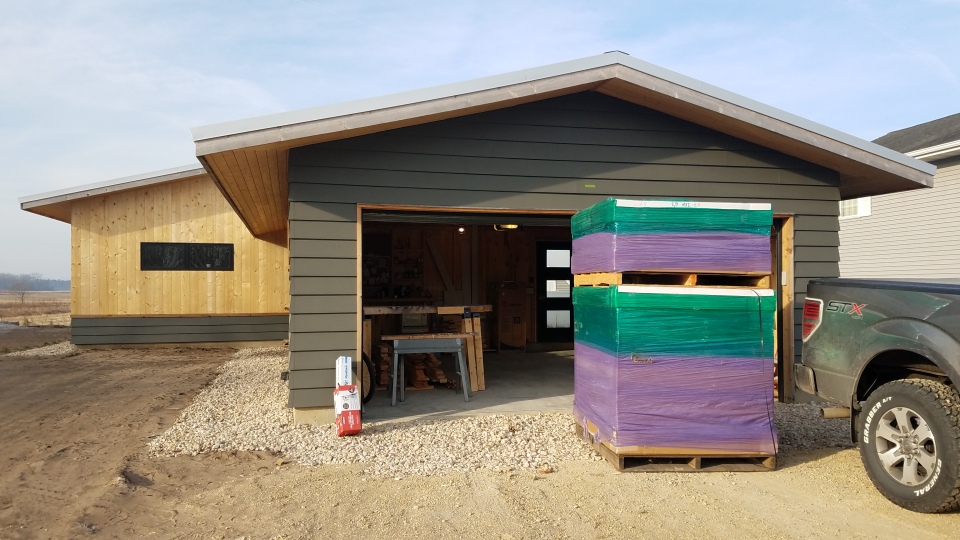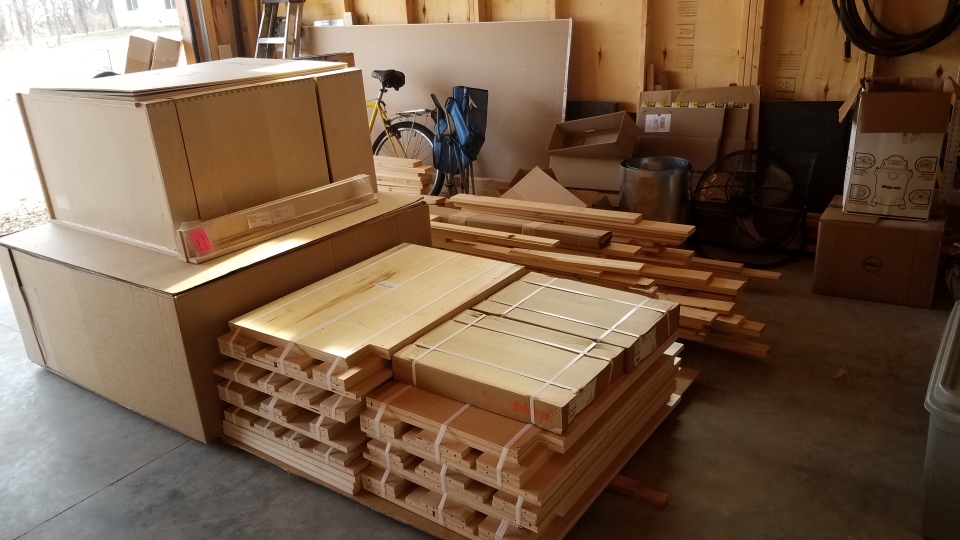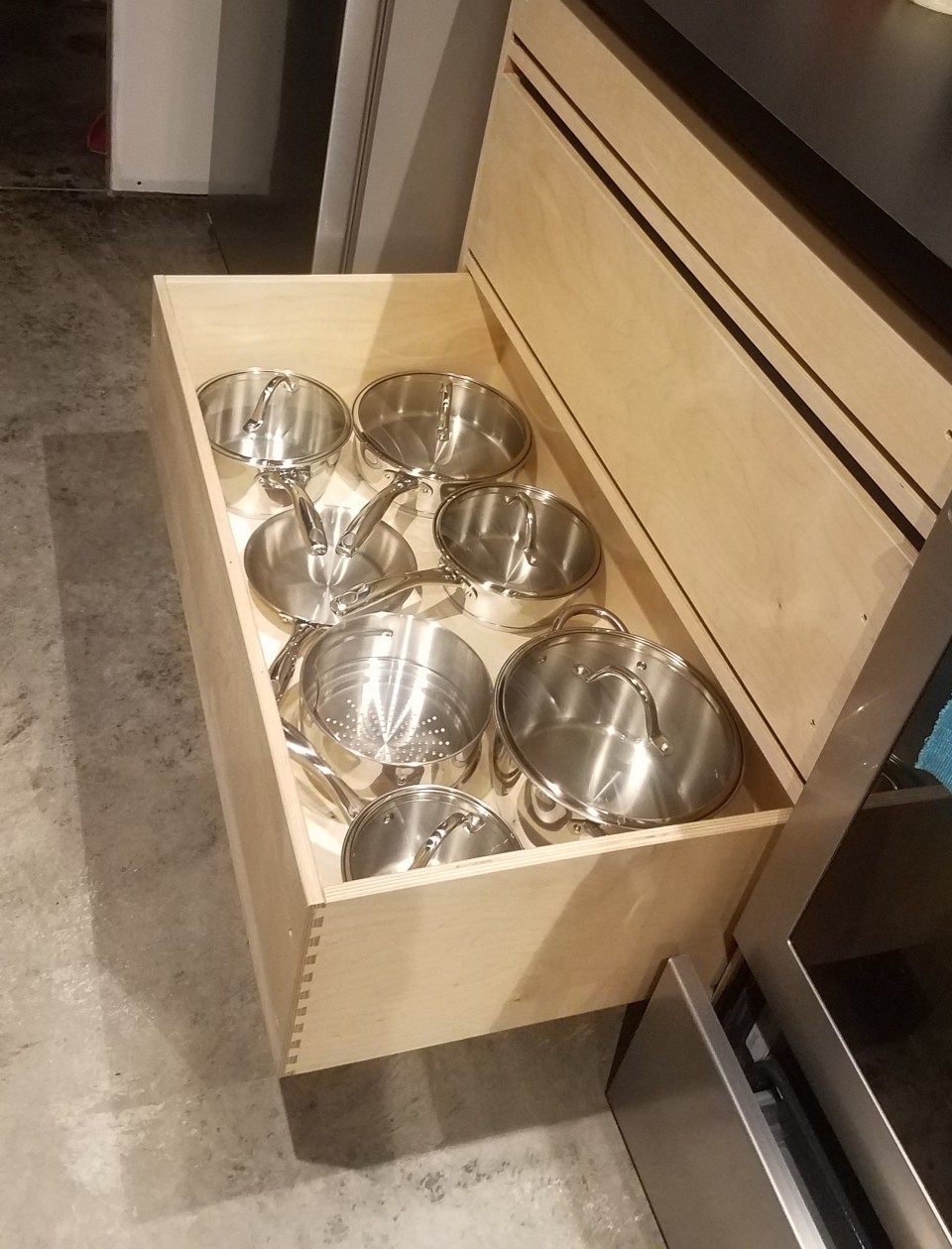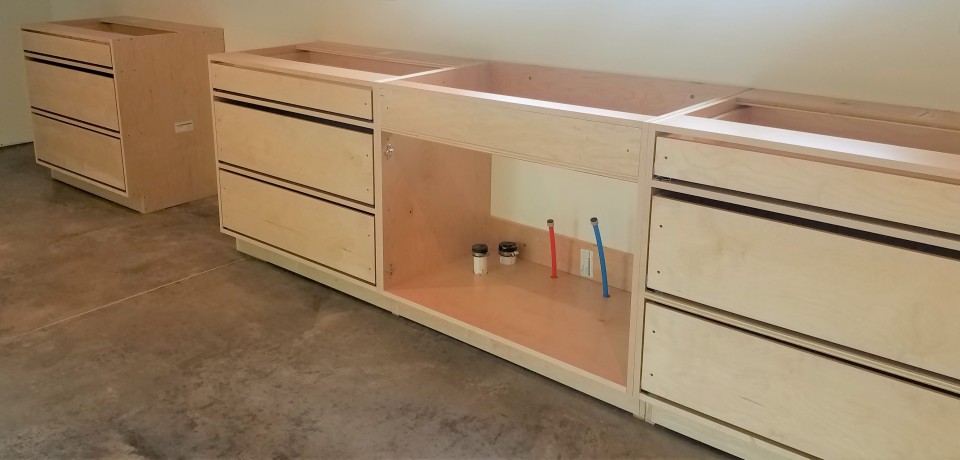April 15-July 14: Putting the kitchen and bathrooms together was fun. All the planning, purchasing, and staging were done and it was time to open boxes. CABINETS: I looked and looked and LOOOOKED for cabinets made with formaldehyde-free plywood. There aren’t many suppliers out there. I finally hit on Barker Cabinets. They had the style I liked, the price was mid-range, and they came with these green credentials:
CABINETS: I looked and looked and LOOOOKED for cabinets made with formaldehyde-free plywood. There aren’t many suppliers out there. I finally hit on Barker Cabinets. They had the style I liked, the price was mid-range, and they came with these green credentials:
- made in America (Oregon)
- cabinet boxes built with NAUF Purebond plywood from U.S. producer Columbia Forest Products
- door frames are solid wood
- inset panels are MDF CARB Phase 2 compliant or better
- prefinished with clear-coat low VOC varnish
- RTA (ready to assemble) cuts down on shipping
 The cabinets were a breeze to put together. I was really impressed with how well-made the wood parts were, and the hardware was good quality.
The cabinets were a breeze to put together. I was really impressed with how well-made the wood parts were, and the hardware was good quality.
I especially like the soft-close, full-extension, undermount Blum drawer glides.
 I chose a simple, straight-edged shaker style door and drawer front on a full overlay style cabinet box for a clean and uncluttered modern look. I had my heart set on painted cabinets, but gulped at Barker’s upcharge (clear coat is much less expensive). Barker had a solution that worked well for me. I could get the cabinet boxes and drawer boxes prefinished, but the doors and drawer fronts “raw”—sanded and ready for my own finish. I ordered “paint-grade alder”. I saved money, got to chose my own color, and didn’t get too bogged down because the work involved only the fronts.
I chose a simple, straight-edged shaker style door and drawer front on a full overlay style cabinet box for a clean and uncluttered modern look. I had my heart set on painted cabinets, but gulped at Barker’s upcharge (clear coat is much less expensive). Barker had a solution that worked well for me. I could get the cabinet boxes and drawer boxes prefinished, but the doors and drawer fronts “raw”—sanded and ready for my own finish. I ordered “paint-grade alder”. I saved money, got to chose my own color, and didn’t get too bogged down because the work involved only the fronts. PAINT: Just as I did for the walls, I chose paint from Ecos, the first American paint manufacturer to meet the strict labeling of both DECLARE and Red List Free. The paint is non-toxic, low-odor, and has zero VOC’s (volatile organic compounds).
PAINT: Just as I did for the walls, I chose paint from Ecos, the first American paint manufacturer to meet the strict labeling of both DECLARE and Red List Free. The paint is non-toxic, low-odor, and has zero VOC’s (volatile organic compounds).
 I used semi-gloss in the same color as the lap siding on the exterior of the house—a dark grayish green. This is one of several ways that I brought the materials, colors, or finishes from outside to inside, creating a more cohesive environment.
I used semi-gloss in the same color as the lap siding on the exterior of the house—a dark grayish green. This is one of several ways that I brought the materials, colors, or finishes from outside to inside, creating a more cohesive environment.
COUNTERTOPS: If you’re trolling for “eco-friendly” countertops, you’ll see just about everything from granite to bamboo to poured-in-place concrete. What makes them “green” is complicated. You could justify just about any selection, and maybe that’s okay. I was interested in old-style linoleum after seeing it used in the Little Kitchen at Frank Lloyd Wright’s Taliesin. The material is appealingly soft and has good green-cred (linseed oil and sawdust)—but takes time and skill and when added up a little pricey. A friend could gift a stainless steel countertop with integral sink yanked out of a restaurant remodel, but I’d have to piece it in with something else to make it work with my cabinet order. I blanched at the cost of Paperstone and its cousin Richlite. Granite was out—it’s too cold and hard and over-used. Plus it’s shipped from overseas. My mind began to turn in a direction that surprised me. What about laminate?
Plastic laminate dominated the countertop market for decades. As a young designer working a kitchen showroom, so-called “postform” was the default. Only my more well-heeled customers even considered dropping several thousand dollars (instead of several hundred) on something better. Laminate was cheap to buy, cheap to install, durable, and came in fun colors and patterns like boomerang.
It’s still cheap and it’s still durable. And……it still looks and feels like plastic. But with a bit of sleigh-of-hand, I thought I might be able to make it look less cheap and more cool. Here are my tricks:
Matte Black: I like boomerangs, but not enough. Instead, go for a color and texture so low-key it disappears.
No Backsplash: nothing says 80’s laminate more than the rounded integral backsplash that the industry calls postform. I’ll use a strip of porcelain tile instead.
Square Edge: for a modern sensibility. The tell-tale “black line” of laminate veneer disappears in the matte black.
Seam: so the problem with laminate is that it comes only so long—my supplier could deliver 12′ max. My longest stretch is 13′. Other countertop materials can be made seamless or nearly so but not laminate. I ordered a 10′ and a 3′ and placed the break over a cabinet seam (not shown in photo below).  Once I’d resolved my aesthetic concerns, I looked into the eco-friendly part. Laminate is made from kraft paper impregnated with formaldehyde based binders that when fused under heat and pressure turn into a purportedly inert plastic. The Formica I chose is GREENGUARD Gold certified for low chemical emissions.
Once I’d resolved my aesthetic concerns, I looked into the eco-friendly part. Laminate is made from kraft paper impregnated with formaldehyde based binders that when fused under heat and pressure turn into a purportedly inert plastic. The Formica I chose is GREENGUARD Gold certified for low chemical emissions.
A good start, but what about the rest? The laminate needs to be glued to particleboard—and particleboard is right up there with carpet for its reputation for off-gassing. Remember the FEMA trailer debacle right after Hurricane Katrina? And new-car smell? Kind of satisfying in a new car, but it doesn’t have quite the same charm in a kitchen. Formaldehyde is prevalent in the building industry, especially in wood sheet products, glues, adhesives, fabrics, carpet, and insulation.
Formaldehyde is a naturally occurring VOC that dissipates quickly when exposed to air, but when trapped in an enclosed space can build up. It can cause throat irritation, burning eyes, coughing, nausea, and itchy skin. It can trigger asthma. Long-term exposure is linked to cancer. Some people have no reaction but other people like me do. I’ve walked onto many a construction site (and finished new home) only to have my throat immediately constrict and a headache start.
The EPA regulates formaldehyde in building products and recognizes these third-party tested labels:
NAUF no-added urea formaldehyde
NAF no added formaldehyde
ULEF ultra low emitting formaldehyde
An online search turned up ULEF labeled “Skyblend” particleboard. It took a few phone calls and a few puzzled salespeople, but my local lumberyard came through. Their supplier could get it.
The squishy thing about the label is that even though it cuts emissions by about half (compared to non-labeled particleboard), no one seems to know how much exposure is too much. Background levels of formaldehyde in a typical urban area are 0.03 ppm (more in heavy traffic). ULEF particleboard must test out at 0.05 ppm (90% of the time). Manufacturers, trade associations, and the EPA itself are silent on the actual benefits of ULEF other than that the product met the number. For now, I’ll think of it the way I think about organic vegetables: surely better for my health and a small way to vote with my pocketbook. So far, my countertops haven’t made me cough and I haven’t had a headache!!
I would have been nervous, but carpenter Eric Wallner was unfazed about the install. The tops were delivered by Tri County Building Supply well wrapped and in perfect shape. Eric executed the splined seam and cut the holes for the sinks. The sinks were set in a bead of non-toxic, low odor silicone caulk called DuraSil from ChemLink—a product I ordered from Green Building Supply.
 I couldn’t be more proud of my somewhat green and I’ll admit it down-market countertops. Tile backsplash to follow.
I couldn’t be more proud of my somewhat green and I’ll admit it down-market countertops. Tile backsplash to follow.
FLOATING SHELVES: I kicked the upper cabinet habit 25 years ago when I remodeled my former farmhouse, and I’m glad to see it’s now trending. There were a couple of thick planks left over from the loft project that would make fine rustic shelves, about 7” wide. They came from a towering pine that stood just a few blocks from here. My friend Jim Birkemeier felled the tree and milled it up at his farm north of town. The planks were dried in a solar kiln. Eric and I chose a section with a ribbon of bark, and another stretch with some interesting knots. We got the idea to stagger the height and notch the ends around the window opening by playing around with them. They are held in place by hidden steel pins screwed into studs behind the drywall.






Looks great work dear, I really appreciate you on this quality work. Good article !! These tips can help me for the future. Granite Countertops
LikeLiked by 1 person